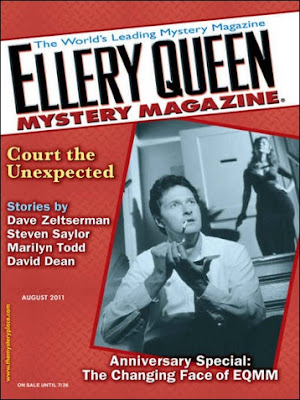Pierre Véry was a French mystery writer, "novelist of adventure, novelist of the fantastic," who believed in preserving "what has been able to remain in us as the child that we were" so "full of flaws, of changes of heart, of shadow and mystery" – describing his own work as fairytales for grown-ups. While steeped in gentle surrealism, Véry was one of the Big Four of the French Golden Age mystery novel. Xavier Lechard, of At the Villa Rose, warns that "anyone expecting to find Christie-like deceptions will be sorely disappointed," but "Véry was quite able to manage brilliant tricks when he wanted" and pointed out Les quatre vipères (The Four Vipers, 1934) as "arguably one of the best locked room mysteries ever written." So, regrettably, only a tiny sampling of Véry's detective fiction has made it into translation.
Back in 2008, Alan Grimes translated and self-published a handful of Véry's whimsical mysteries that included two Prosper Lepicq novels, L'assassinat du Pére Noël (The Murder of Father Christmas, 1934) and Le thé des vieilles dames (The Old Ladies' Tea Party, 1937). The translations have since gone out-of-print, out-of-stock and secondhand copies are now difficult to find. Three years later, John Pugmire translated Véry's pastiche of Gaston Leroux's Le mystère de la chambre jaune (The Mystery of the Yellow Room, 1907). And that short story is not difficult to find.
Pugmire's translation of "Le mystére de la chambre verte" ("The Mystery of the Green Room," 1936) appeared in the August, 2011, issue of Ellery Queen's Mystery Magazine and anthologized in Foreign Bodies (2018). "The Mystery of the Green Room" is an inspired and immensely enjoyable take on Leroux's The Mystery of the Yellow Room, but, let the reader be warned, you should not read Véry's pastiche without having read Leroux's historic genre milestone – whose solution is integral to the plot of "The Mystery of the Green Room." A plot concerning an otherwise ordinary-looking burglary and robbery, where it not for a very peculiar feature.
Madame Emilienne de Rouvres is attacked in her own home, gagged and bound to a chair, while a masked individual ransacked the place. This person helped himself to the silverware, a small clock and several thousands francs from the wall safe, but these were meager pickings compared to Madame de Rouvres jewelry. A pearl necklace and a string of diamonds, "estimated to be worth eight hundred thousand francs," which were kept in the drawer of a bedside table in the green room ("I imagine safes attract burglars like bears to honey"). However, the thief only poked his head in from the doorway, but never stepped into the bedroom. So the small fortune lying there for the picking remained untouched. Marcel Fermier, private insurance investigator, remarks to the Inspector Jean Martin that the green room puzzle is exactly the same as the yellow room puzzle from Gaston Leroux's famous locked room mystery "in the sense that it's the precise opposite." An open-room puzzle. The thief had every opportunity to have gone into the green room, take jewelry and come out again. So why didn't he?
"The Mystery of the Green Room" was published in the same year as Leo Bruce's Case for Three Detectives (1936) and you can draw similarities between the two with their rivaling detectives ("while the policeman looked for clues, Fermier tried to determine the motive"), humor, false-solutions and cleverly spoofing Leroux – modeling the correct solution on "a parallelism of opposition" between the green and yellow room puzzles. And it worked so incredibly well! A tiny gemstone of the detective pastiche and a wonderfully done, immensely enjoyable homage to one of the most famous locked room mysteries of the 20th century that's actually not a locked room mystery itself. And, again, it worked! Highly recommended! Hopefully, this is not the last we have seen of Véry on this side of the language barrier. Le testament de Basil Crookes (The Testament of Basil Crookes, 1930) and The Four Vipers sound too good not to be exposed to a wider, international audience.


No comments:
Post a Comment